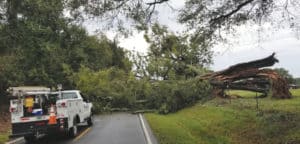YEC understands many members have been affected by the recent storms in our area. During Easter weekend, approximately 25% of our membership, across our entire service territory, experienced an outage. This is the largest amount of damage we have seen in more than 10 years. We appreciated your patience as we worked to make repairs, restoring power to all accounts by the next day. As our crews work to safely repair damages from severe weather, we want our members to understand the work we do ahead of time to prepare and what it takes to get your lights back on. Vice President of Energy and Delivery Denny Lynn offers insight on storm work and life on the line.
What is the biggest challenge we face when we have a storm?

Lynn: We face many challenges during and after a storm. Challenges include staying safe in storm damaged working conditions and finding access through the damage to our facilities. Above all, we want to make sure our employees are protected and stay safe. There is also a struggle of balancing our strong desire to restore service quickly with ensuring the safety of our employees, making sure they receive proper rest and nutrition. It is also challenging to determine how to best utilize our available YEC resources to best serve our members, as well as acquiring other assistance and resources from other cooperatives and contractors.
What precautions do we take to prevent storm damage?
Lynn: YEC is proactive in annual preventative maintenance on all aspects of the electric distribution system. From our aggressive right of way schedule, to maintenance and upgrades to facilities on all parts of our system, we always have storms and excellent service in mind. YEC stays on an annual maintenance process, constantly working to make the electric distribution system stronger and better.
Why do some repairs take longer than others?
Lynn: Repairs that take longer are often due to the extent of the damages and the problems of access to lines and facilities. Our employees are well trained and proficient in performing restoration in difficult situations and challenging conditions, but these situations of extensive damage and difficult access do extend restoration times occasionally. Many people are involved when a storm hits.
Can you describe the teamwork that takes place at YEC?
Lynn: Every department and every employee of YEC is actively involved in the restoration process after a major storm hits. We all have a predetermined role that is part of the overall storm response plan. There is a great deal of support work that goes on behind the scenes, including food planning and preparations, answering calls and inquiries from members, coordinating the procurement of materials, continued maintenance and repairs of equipment, communicating with members on our restoration efforts, lodging for out of town crews offering assistance and organizing financial resources to pay for materials. I’m sure I haven’t listed each role played by our team, but you can see there are many key areas that are not readily seen on the forefront of the overall restoration effort.
Describe the hazards that come with storm work and YEC’s safety culture.

Lynn: Storm restoration work on an electric distribution system is filled with hazards of every imaginable sort. Large downed trees on power lines, safely handling and working with high voltage, working high in the air on equipment and climbing high voltage poles—all in adverse weather conditions, among debris, while being physically and mentally tired. The hazards often seem overwhelming to us, which is why we work so hard every single day, all year long, to provide everything that our employees need to perform our work safely and efficiently. This includes proper tools, well-maintained equipment, proper training, sound communication, good safety processes and procedures, a well built and well maintained electrical distribution system and, most of all, a strong culture of good safety habits, processes, procedures and protocols that protect our employees. We appreciate the consistent support from our board of directors to continue this culture of safety and education.
How do you approach storm damage? How do you decide what gets attention first?
Lynn: Our initial reaction and response in a storm situation is to quickly assess exactly what is “out” and what areas have been affected. That assessment is typically being done as YEC personnel are reporting to work. All electric utilities perform restoration efforts in a similar fashion. First, we work to restore main lines or feeders and main circuits, thus restoring service to the most members at one time as quickly as possible. Taps, or lines off the main feeders and circuits are assessed and repaired next. Performing restoration efforts in this manner has proven, time and again, power is restored faster for the entire electric system and all affected members.
Mending the Mess
YEC linemen documented the hazards they encountered before mending the mess to get the lights back on for members as quickly and safely as possible.
